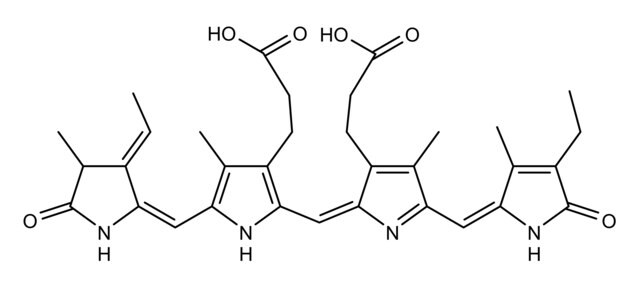E4011
ExtrAvidin®−R-Phycoerythrin
buffered aqueous solution
Synonym(s):
R-Phycoerythrin
About This Item
Recommended Products
conjugate
phycoerythrin (R-PE) conjugate
form
buffered aqueous solution
storage condition
protect from light
extent of labeling
1-4 mol PE per mol ExtrAvidin®
technique(s)
flow cytometry: suitable using human peripheral blood lymphocytes with biotinylated antibody
immunohistochemistry (formalin-fixed, paraffin-embedded sections): 5 μg/mL using human tissues
storage temp.
2-8°C
General description
The extravidin-R-phycoerythrin protein can be conjugated with fluorescein-labelled arylacetamide, a κ opioid ligand and biotin-conjugated anti-fluorescein IgG to identify the subpopulations of thymocytes that express κ opioid receptor. This product has shown specificity for rabbit anti-avidin in immunoelectrophoresis analysis.
Immunogen
Application
- In flow cytometric analysis to confirm membrane expression of ncamp-1 (cationic oligodeoxynucleotide binding protein).[1]
- In indirect immunofluorescence.[2]
- In Western blotting.[3]
Physical form
Legal Information
Disclaimer
Storage Class
10 - Combustible liquids
wgk_germany
WGK 2
flash_point_f
Not applicable
flash_point_c
Not applicable
Choose from one of the most recent versions:
Certificates of Analysis (COA)
Don't see the Right Version?
If you require a particular version, you can look up a specific certificate by the Lot or Batch number.
Already Own This Product?
Find documentation for the products that you have recently purchased in the Document Library.
Customers Also Viewed
Articles
Flow cytometry dye selection tips match fluorophores to flow cytometer configurations, enhancing panel performance.
Troubleshooting guide offers solutions for common flow cytometry problems, ensuring improved analysis performance.
Protocols
Learn key steps in flow cytometry protocols to make your next flow cytometry experiment run with ease.
Explore our flow cytometry guide to uncover flow cytometry basics, traditional flow cytometer components, key flow cytometry protocol steps, and proper controls.
Our team of scientists has experience in all areas of research including Life Science, Material Science, Chemical Synthesis, Chromatography, Analytical and many others.
Contact Technical Service









